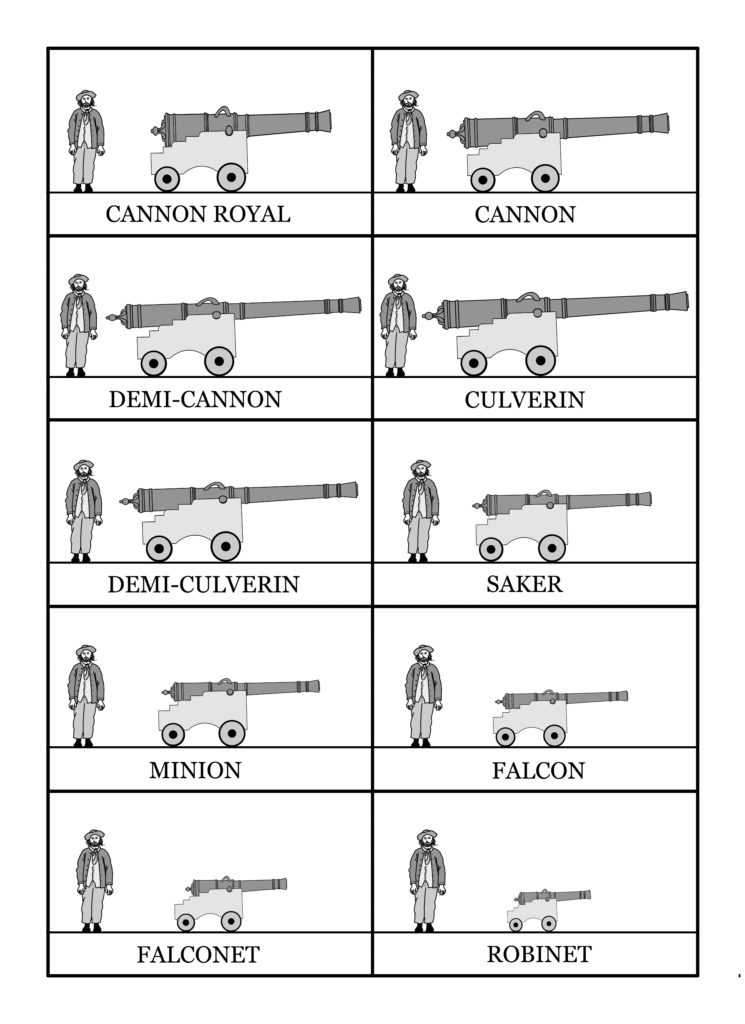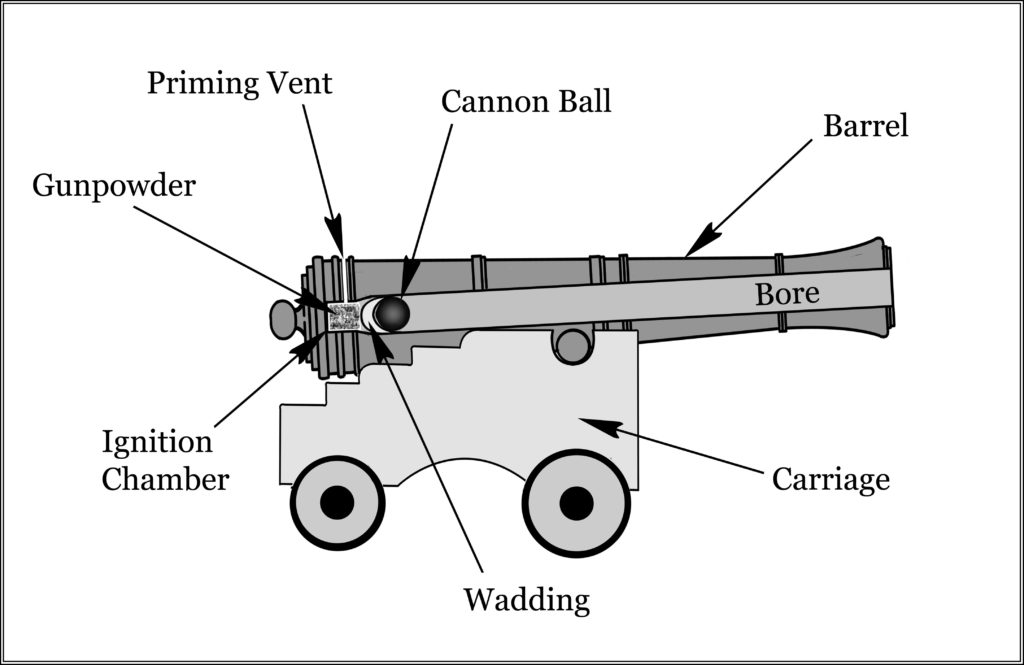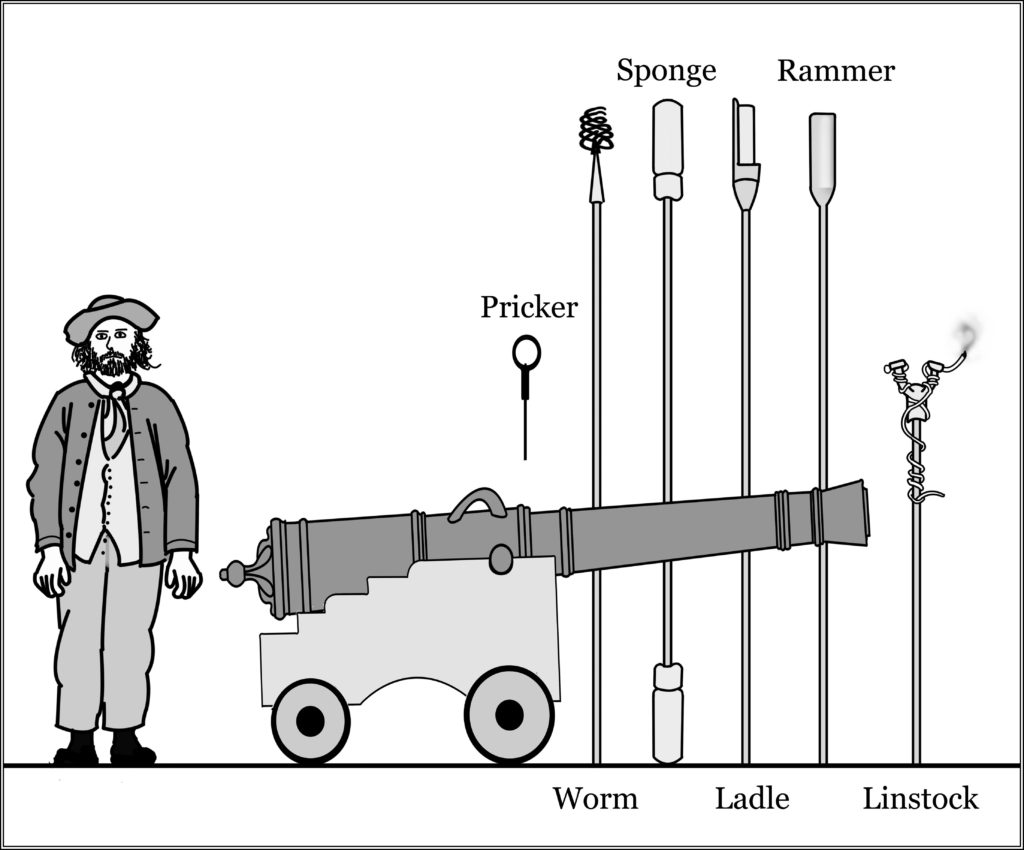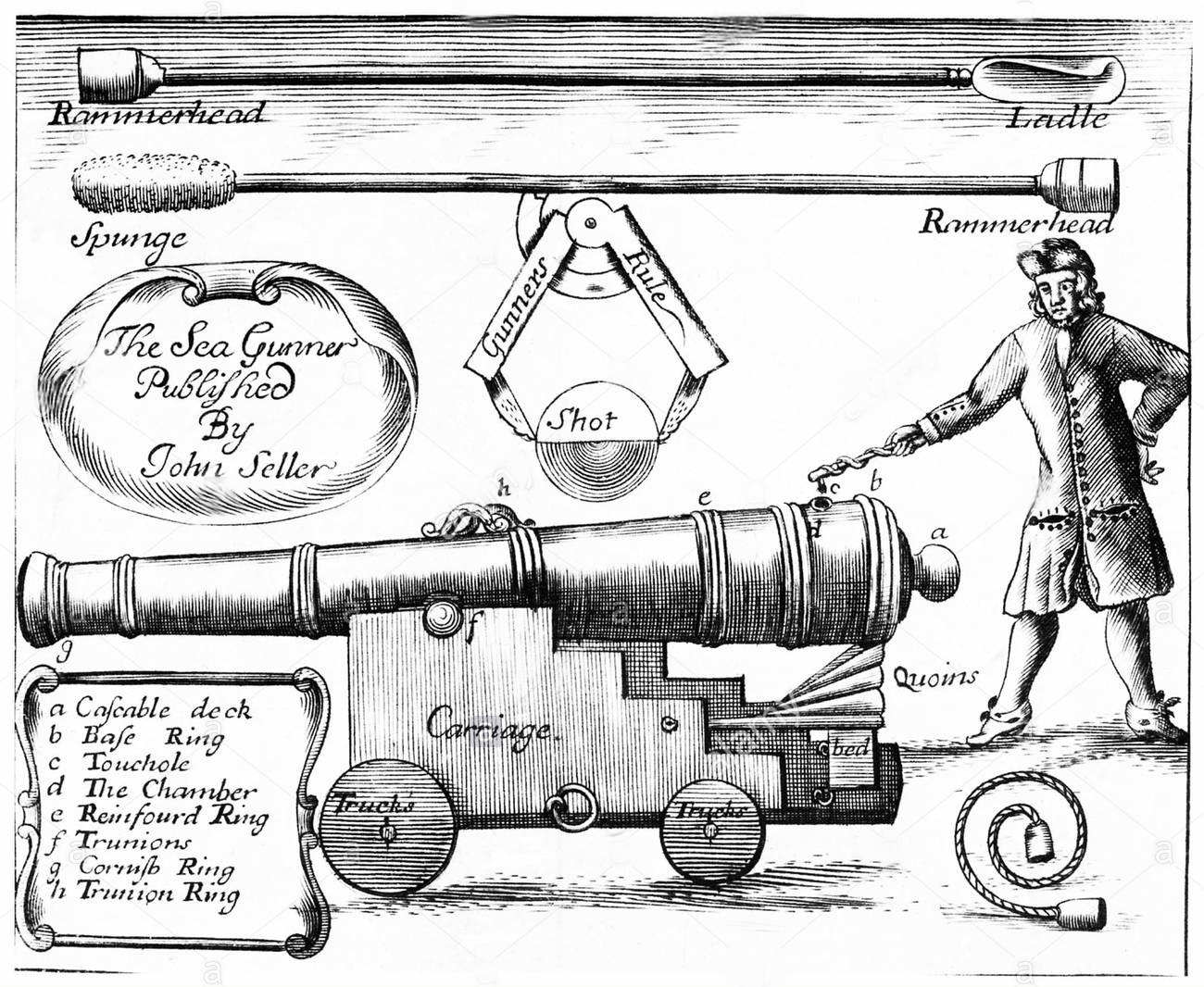(This post is a continuation of Cannons – Part 1. If you haven’t done so already, it’s best to read that post before continuing on here.)
By modern-day standards, seventeenth century ships’ guns were quite primitive firearms. They consisted of a simple bronze or iron tube into which you stuffed a load of gunpowder, making sure it got all the way down into the bottom end, followed by a cannon ball. You then set the gunpowder alight and… BOOM! The cannon ball soared off and smashed into something.
Simple.
Simple, however, is not necessarily the same thing as easy.
Firing one of these old guns might not have been a particularly technical procedure, but it required a series of steps that had to be done just right—and that often required a lot of brute physical exertion. Two or three men might be able to push or haul a smaller gun around by hand, but the very big ones like the cannon royal could weigh as much as four tons. Maneuvering a cannon royal on the gun deck of a ship could take a team of over a dozen men, sweating and straining on block-and-tackle arrangements to haul the thing about and get it where they needed it to be. Even a smaller gun like a minion could still weigh a ton and a half.
It is useful to keep in mind just how large—and so just how heavy and unwieldy—some of these guns were. The illustration below shows the relative sizes of the ships’ guns listed in the chart provided in the previous post in this Cannons series (Cannons – Part 1). The guns and the human figure are all to scale.

The basic process of firing any of these guns was the same, regardless of size. Bigger guns just required more men—and more exertion on the part of those men—to fire than smaller ones.
To understand the actual firing process itself, it helps to be able to visualize two things: 1/ the architecture of the gun; 2/ the tools required.
The illustration below shows a cutaway view of a generic cannon.

As you can see, it’s basically just a hollow metal tube resting on a wheeled platform (the carriage, also sometimes known as the truck). The hollowed-out part of the barrel is called the bore. At the back end of the bore (technically referred to as the breech) is the ignition chamber, where the gunpowder sits. The cannon ball, preceded by some wadding, is stuffed down the bore until it rests against the gunpowder, which is then set alight via the vent.
Doing all this, though, requires specialized tools. The illustration below depicts those tools, along with a generic, medium-sized gun and a gunner, all to scale.

The pricker is used to ream out the vent to keep it unobstructed. The worm is used to scrape the bore clean of any residue from a previous firing. The sponge is used to clean out the bore. The ladle is used to push the charge of gunpowder down the bore. The rammer is used to tamp the cannon ball hard against the charge of gunpowder at the base of the bore. The linstock is used to light the gunpowder via the vent.
So here’s how the process works…
PREP
To start, you have to haul the gun back across the ship’s deck, away from the gun port, so that you can have access to the barrel. Once you’ve done that, you can prepare the gun for firing. Before anything else, especially if the gun has recently been fired, you need to insert the worm tool—a long wooden handle with what amounts to a kind of wire brush at the tip—into the bore to scour its interior and haul out any residue left over from previous firings, such as remnants of the “cartridge,” the cloth bag that encases the gunpowder charge (see below). The next step is to dip one end of the sponge tool—a long wooden handle with wads of absorbent wool wrapped around the tips—into a bucket of seawater (kept on deck nearby) and then use it to carefully swab out the bore. Since you’re about to load a charge of highly explosive gunpowder into it, you don’t want any hot embers left alive in the bore from a previous firing. And since you also don’t want the gunpowder you are about to insert into the bore to get damp, you then flip the sponge tool around (or employ another sponge tool) and use a dry sponge to mop out the bore, leaving it clean and dry and ready for loading.
LOADING
Once the bore is safely prepped, you need to load the gunpowder. You can’t just pour handfuls of gunpowder into the mouth of the bore, though. In a small muzzled-loading gun like a hand-held musket, you can tilt the barrel upright, so that it is vertical, and just pour the gunpowder in, letting gravity do the work. For obvious reasons, this approach isn’t going to work with a ship’s gun weighing half a ton or more. So the gunpowder is carefully pre-wrapped into individual cartridges—cloth bags containing the necessary charge. For a cannon royal, that could be as much as 35 pounds (15 kilos) of gunpowder. Even for a relatively small gun like a falcon, the cartridge still held a couple of pounds (a kilo or so) of gunpowder. The cartridge containing the gunpowder is inserted into the bore using the ladle. The ladle has a long wooden handle and a kind of scoop at the end (sometimes the sponge and the ladle were combined into a single tool). This scoop is made of copper, to reduce the risk of sparks as it is shoved down the bore. The cartridge is seated in the scoop, so that it is cupped by the scoop’s curved blade. The ladle is then thrust into the bore. When the scoop reaches the end of the bore, you give the ladle a half twist. As a result, the blade of the scoop no longer cups the cartridge but, instead, rests free above it. You then withdraw the ladle, leaving the cartridge behind. If you’re conscientious, you then also use the rammer—a long wooden handle with a sort of wood plug at the end the same diameter as the bore—to gently force the cartridge firmly into the ignition chamber.
Next, you load the cannon ball. First, though, you insert a piece of wadding (a patch of cloth) into the mouth of the bore. You then force the cannon ball against the wadding and down into the bore. The wadding ensures that there is as little windage—as little space between the cannon ball and the sides of the bore—as possible. This provides maximum pressure when the gunpowder ignites and sends the ball hurtling off. You use the rammer to force the ball down the bore so that it sits firmly against the cartridge in the ignition chamber. After this, you haul the gun forwards so that the muzzle projects out through the gun port and the gun is in the proper position to be fired.
The last part of the loading stage is priming. These old ships’ guns had no trigger to fire them. You had to directly ignite the cartridge in the ignition chamber. You do this via the vent. The vent is a small hole drilled through the top of the barrel (at the breech end) straight down into the ignition chamber. Your next step is to thrust the long thin prong of the pricker into the vent, to ensure that it is clear all the way down to the cartridge. In the process, you also punch a hole in the cartridge itself, ensuring that a spark will ignite the gunpowder within the bag. With the vent clear and the cartridge bag punctured, there’s one final step needed before you can fire the gun. You need to load priming powder into the vent. Priming powder is finely ground gunpowder. It provides an initial burn that then sets off the main charge in the cartridge. You can, in theory, dribble the priming powder down into the vent until it fills up, but on the heaving deck of a ship, that could be a tricky procedure. Gunners had various solutions to this problem. One was to use the hollow spine of a large turkey quill feather they had previously filled with priming powder. Such a pre-made ‘fuse’ can be jammed down into the vent… leaving you ready for the final stage.
FIRING
Firing is done with the linstock, a forked stick with a length of smoldering cord wound round it. You need the stick so you can reach out and fire the cannon while standing safely out of the way of the recoil. The cord on the linstock was known as a slow match. It was impregnated with a flammable substance (usually saltpeter) so that it would burn continuously but slowly (about four or five inches an hour or thereabouts). Using such a slow march was the standard method for firing all ships’ guns—large or small—right up until the ninteenth century.
You fire the gun by reaching out and touching the burning end of the cord to the vent hole. This sets off the priming powder, which burns instantaneously down through the vent hole and sets off the charge in the cartridge.
BOOM!
____________________
The description above might make the firing process seem like a one-man procedure. It was not. It took multiple men, trained and experienced in what they had to do, working as a team. The bigger the gun the larger the team, since hauling a big gun back and forth takes brute manpower. Even the seemingly simple task of loading the cannon ball could be a challenge if the cannon ball weighed 65 pounds (30 kilos). Making the process run smoothly and effectively took real skill and coordination—an especially difficult feat on a heaving ship’s deck in the noisy, smoke-shrouded, violent chaos of a sea battle.
One last question, of course, remains: How effective—how deadly—were these seventeenth century ships’ guns?
See the next post in this Cannons series (Cannons – Part 3) for that.

Corsairs and Captives
Narratives from the Age of the Barbary Pirates
View Amazon listing
The Travels of Reverend Ólafur Egilsson
The story of the Barbary corsair raid on Iceland in 1627
View Amazon listing